【美国移民】必读 – 奥巴马移民改革,享受红利的正确姿势 | 专家解读
上个月这个时候,EB5Sir发布了对于10月签证公告牌巨变的介绍,以及所谓的奥巴马大礼包的期待。当然,最后移民局(USCIS)预定的电话会议未开,同时USCIS又在9月25日对签证公告牌做了不利于申请者的变更,现在正在被美国移民律师起诉,虽然该次变更并未影响到EB-5申请者,但是从中也许能嗅出USCIS内部的反移民倾向和对奥巴马放松移民政策的不满。
今天,我们来看下Bernard P. Wolfsdorf对于10月签证新政的专业解读。10月份已经开始,新政策已经开始实施,再马上,11月份的新的签证公告牌就要出来了,让我们好好看看怎样才能正确享受奥巴马红利。当然,关于签证和排期的问题,特别多技术术语,非常难于理解,看完之后能明白全文所指的都非普通业内人士。普通投资者,完全可以跳过前面的所有问题,只去看第8个到第13个问题,或者只看问题12和13,我敢打赌,你最关心的问题在那里,而且一定能看懂。本文由业内朋友Dora翻译,特此感谢。
EB-5最新进展——对2015年10月的签证公告变化的理解——投资者何时递交I-485调整状态申请?
1. 为了理解签证公告牌,必须学习以下术语:
签证公告牌(Visa Bulletin - VB)→ 每月颁布一次
最新签证公告牌(New Visa Bulletin - NVB)→ 2015年10月
优先日(Priority date - PD)→ I-526申请的收件日期
截止日(Cut-Off Date - COD)→ 旧签证公告
最终裁定日(Final Action Date - FAD)→以前的截止日
递交申请日(Date Filing Application - DFA)→ 新调整状态申请递交日——[以前仅指签证中心发出费用单的日期]
2. 为什么会有这些改变?
在2014年11月20日,美国国土安全局(DHS)指示美国移民局(USCIS)与国家签证中心(DOS)一起工作改进签证公告系统。2015年7月16日,奥巴马政府颁布了一份报告,为了21世纪现代化和精简我们合法的移民系统。因此,USCIS/ DOS修订了签证程序,来确定等待申请调整身份的申请人是否有可用的签证。这种变化增强了准确地预测总体移民签证需求的能力并最小化月度的波动。
3. 什么是优先日(PD)及其重要性?
EB-5优先日(Priority Date - PD)是USCIS收到EB-5之I-526申请的日期。签证公告(VB)在每个月的9日或10日更新优先日期,或根据需要,采用新的截止日期(COD)。只有PD处于“当前”状态时,才能在国外领事馆/大使馆安排最终的面试或批准调整状态的申请。以前,只有PD处于“当前”状态时,才能够递交I-485调整状态的申请。
然而,我们现在公布了合格日期。在中国出生的申请者,10月公告的合格日期是2015年5月1日。这个日期是新设立的,并且是在2015年10月可以递交调整状态申请的日期(Date Filing Application - DFA)。如果PD早于DFA,例如2015年4月30日,外国申请者就可以递交其I-485申请。
4. 新的签证公告牌(NVB)有两个表,一个适用于递交申请和一个适用于批准
递交申请日(DFA)
→可以递交I-485调整状态申请
→NVC(国家签证中心)发出付费和提交文件通知给申请人
最终裁定日(FAD)
→ I-485调整状态申请获批
→ 最终领馆申请获批
DFA表,用于确定是否还有签证配额和是否可以递交额外的I-485申请。否则,就必须使用FAD表。USCIS和DOS一起监控每月签证配额,并在其官网上公布相关表格。
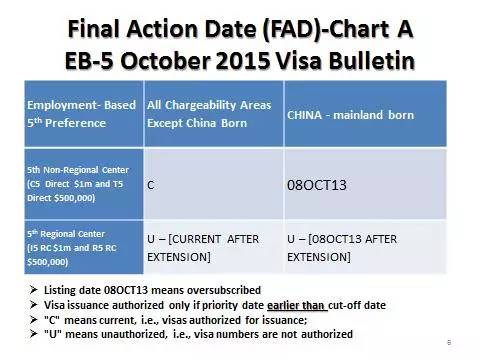
上表翻译如下:
最终裁定日(FAD) —— 表A
2015年10月EB-5签证公告牌
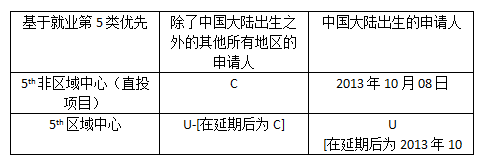
→ 表中所列的2013年10月08日,意味着申请者已经超出签证配额
→ 只有优先日早于截止日才能获得签证
→ “C”的意思是目前,也就是说还有签证配额
→ “U”的意思是未授权,也就是说没有授权签证数量
注:DOS只更新了反映区域中心延期至2015年12月11日的表B。VB的D部分表明:“10月份,除了中国大陆出生之外的所有国家,SR,I5和R5签证类别 … 立即变成了”当前”,而对于中国大陆出生的申请人,I5和R5类别的截止日为2013年10月8日。
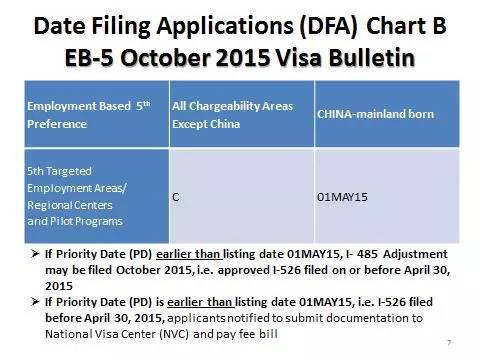
上表翻译如下:
递交申请日(DFA)—— 表B
2015年10月EB-5签证公告牌

→ 如果优先日早于表中给出的2015年5月01日,并且在2015年4月30日之前获得了I-526申请的批准,可以在2015年10月递交I-485调整状态申请。
→如果优先日早于表中给出的2015年5月01日,并且在2015年4月30日之前获得了I-526申请的批准,申请者会被通知递交文件给到国家签证中心(NVC)并支付费用。
5. 最新消息?
在2015年10月之前,获得I-526申请批准的投资者,只有在其优先日(PD)早于截止日(COD)的情况下,才能够递交其I-485申请。
在2015年10月1日之后,如果他们的I-526优先日(PD)早于递交递交申请日(DFA),那么他们可以递交其I-485申请。对于中国大陆出生的申请者而言,无论是做直投项目还是区域中心项目,其DFA日期都是2015年5月1日。在2015年10月1日之后,所有非中国大陆出生的申请人,无论是做直投项目还是区域中心项目,只要他们的I-526申请获批,就可以递交其I-485申请。2015年9月30日,国会通过了一项决议将EB-5区域中心项目短暂延期至2015年12月11日。因此,在当前状况下,投资人可以继续递交申请直至12月11日。
6. EB-5新签证公告牌的影响
大约在每个月的9号,新的签证公告牌(NVB)将给出一个提交签证申请日期(DFA)(见表A),和最终裁定日(FAD)(见表B)。
一旦PD处于当前状态,(即早于表B中列出的FAD),EB-5签证可以颁发给外国申请者,或申请者的调整状态申请可以被批准。USCIS表示,2015年10月,表A中的DFA可以用于递交调整状态的申请。
像以前一样,根据需求,“批准”或FAD截止日每月可能会改变。但是“接受”或DFA截止日一般会保持不变,或全年可能稍微向前前进一点。
7. 10月的EB-5签证公告牌的简化解读
→ 直投项目(C5和T5)
DFA——中国大陆出生的申请人→2015年5月1日
DFA——非中国大陆出生的申请人→当前
FAD——中国大陆出生的申请人→2013年10月8日
FAD——非中国大陆出生的申请人→当前
→ 区域中心(I5和R5)
FAD——中国大陆出生的申请人→未授权(在国会延期后——2013年10月8日)
FAD——非中国大陆出生的申请人→未授权(在国会延期后——当前)
对区域中心而言,截止日是“未授权”,但是对所有非中国大陆出生的申请人,EB-5计划延期的立法行动已经确认10月的截止日为“当前”。而中国大陆出生的区域中心项目申请人,其截止日为2013年10月8日。
如签证公告牌D部分中指出的那样:
如果有立法行动将 [SR、I5和R5签证] 类别延期至2016年财政年度,对于所有非中国大陆出生的申请人,10月的这些截止日将立即成为“当前”,而对于中国大陆出生的申请人,其I5和R5类别的截止日将为2013年10月8日。
8. 在美国申请调整状态的优势
主申请人和合格的家庭成员,包括配偶和子女,在提交I-485申请后大概90天内,就可以获得就业许可和提前假释旅行许可(advance parole travel authorization)。这些许可,每年都可再获新的授权,直到拿到永久居留。最重要的是,儿童状态保护法案(CSPA)提供了锁定和冻结孩子的年龄的能力。由于中国EB-5配额排队主要影响在I-526申请获批后孩子年龄超过21岁,能够通过递交I-485申请来冻结孩子的年龄,为儿童年龄保护提供了最好的选择。
9. 基于I-526获批后递交调整状态申请的三个要求:
* 在签证公告牌上,签证数量必须是“可用”的;
* 申请人必须持续保持合法的非移民身份。
(因为依据245(i)条款,EB-5调整状态只豁免早于2001年4月30日之前递交的绿卡申请。即使重新获得F-1身份者也被禁止,因为曾经没有身份,对于EB-5申请者,没有245(k)条款的选项允许原谅过去的非法居留状态。)
* 申请人没有打过黑工。
10. EB-5调整状态的计划,以及B类签证和F类学生签证的相互作用
去年中国签证互惠计划调整,允许签发10年期的旅游签证和5年期的学生签证。2015年7月16日,奥巴马总统颁布政府的签证现代化提案,明确投资者是否可以获得旅游签证来到美国核查他们的投资项目。他们还寻求明确在申请时评估学生签证的目的。
11. 大约90%的EB-5签证是通过国外的领馆程序 (8,641例中有7,772例)。
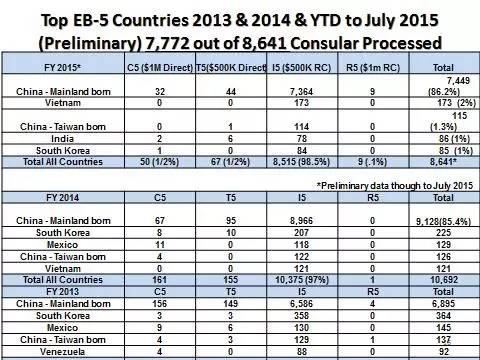
上表翻译如下:
2013、2014财年和截止到2015年7月EB-5申请人最多的国家
8,641例中有7,772例领馆程序
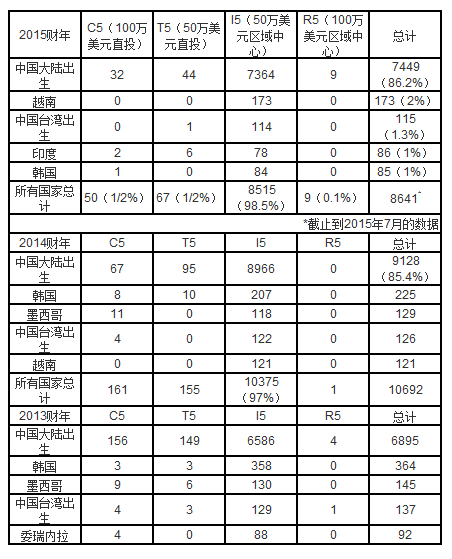
12. 我可以进入美国吗? 现在递交调整状态申请?
既然有大约90%的海外EB-5申请人走领事程序,问题是现在是否要进入美国递交调整状态申请。很显然,拥有“双重意图”签证的人——H-1B工作签证或L-1公司高管签证,如果他们获得I-526申请批准并且已经到达DFA日,可以进入美国并立即递交调整状态申请。
如果有人在新的签证公告宣布之前以B-2签证进入美国,并且在进入后,发现他或她有资格递交调整状态申请,这也不可能会有任何"先入为主的意图"或签证欺诈问题。问题在于F-1学生是否必须在进入美国后等30或60天之后再递交调整状态申请。最好是等待至少30天,当然答案不是特别明确。
13. 应用30/60天规则
在确定是否存在签证欺诈时,最困难的问题起源于涉及人在美国的案例。他们的行为与他们在申请签证时,对领事官员或他们在申请进入时对移民官员做出的表述并不一致。规则指出,“对外国人,在获得非移民签证后,申请调整状态成为永久居民时,这种案例经常发生。”
由于国务院已经颁布了30/60天规则,如果申请人在进入美国30天内,递交调整状态申请,政府可以推测他或她在寻求签证或入境时虚假陈述。发现虚假陈述或欺诈可能导致申请人一生都被禁止进入美国。
如果递交调整状态申请发生在进入美国超过30天,但不到60天内,不会出现虚假陈述的推定。但是,如果有事实导致合理认为虚假陈述,那么申请人必须提供反虚假陈述的证据。
如果递交调整状态申请行为发生在进入美国超过60天之后,通常就不会有虚假陈述或不得入境的情况了。
(EB5Sir注:道这是绝大多数投资者最关心的问题,在现有政策情况下,通过B类签证转身份难度比较大,关键是你不知道何时I-526获批,而在美国停留时间有限,很难满足30/60规则。)
结论
由于大多数主申请人都不在美国,所以只有很少在美国的学生可以递交调整状态申请。如果存在签证排期,甚至刚刚结婚的配偶都可能无法加入到,主申请人的签证申请中。最大的问题是,USCIS是否会允许2015年11月和12月的EB-5调整状态申请,还是这仅是10月份的一次性的红利。USCIS应该允许EB-5申请人继续递交调整状态申请,因为很少有人能够在10月份递交调整状态的申请。另一大问题是USCIS是否会批准I-526申请获批者的假释入境(parole entry),这样他们就可以在美国递交调整状态申请。不管怎样,这项新举措对一些人来说,是好的进展,虽然尚不清楚有多少EB-5的申请者将会受益。
原文作者:Bernard P. Wolfsdorf律师,原文出处:www.wolfsdorf.com.
EB-5 Update-Understanding the October 2015 Visa Bulletin Changes — When to File Investor-Based I-485 Adjustments?*
09/27/15
By Bernard P. Wolfsdorf, Esq.
THIS BLOG DOES NOT CONSTITUTE LEGAL ADVICE. TO OBTAIN LEGAL ADVICE CONSULT WITH A LICENSED AND KNOWLEDGEABLE IMMIGRATION LAWYER.
*Copyright © 2015 Wolfsdorf Rosenthal LLP
To understand the Visa Bulletin, one needs to learn the terminology
Visa Bulletin (VB) → PUBLISHED MONTHLY
New Visa Bulletin (NVB) → OCTOBER 2015
Priority date (PD) → DATE I-526 RECEIVED
Cut-Off Date (COD) → OLD VISA BULLETIN
Final Action Date (FAD) → FORMERLY COD
Date Filing Application (DFA) → NEW FOR FILING ADJUSTMENT – [FORMERLY ONLY NVC FEE BILL ISSUANCE DATE]
Why the changes?
On November 20, 2014, DHS directed USCIS to work with the Department of State (DOS) to improve the Visa Bulletin system. On July 16, 2015, the Obama Administration issued a report Modernizing and Streamlining Our Legal Immigration System for the 21st Century. As a result, USCIS/DOS revised the procedures for determining visa availability for applicants waiting to file for adjustment of status. This change enhances the ability to more accurately predict overall immigrant visa demand and minimize month-to-month fluctuations.
What is a Priority Date (PD) and What is its Significance?
An EB-5 Priority date (PD) is the date USCIS receives the I-526 EB-5 petition. The Visa Bulletin (VB) is updated on the 9th or 10th of each month, or as needed, with the new Cut-Off Dates (COD). See http://travel.state.gov/content/visas/english/law-and-policy/bulletin.html. A PD must be “Current,” to schedule a final interview at a Consulate/Embassy abroad or to approve an application for adjustment of status. Previously, the PD had to be “Current” to file an I-485 adjustment. However, we now have published qualifying dates. In the case of Chinese born applicants, the published qualifying date is May 1, 2015. This date is new and is the Date for Filing Application (DFA) for October 2015. If the PD is earlier than Date Filing Application (DFF) e.g. April 30, 2015, a foreign national may be eligible to file an I-485 application.
The New Visa Bulletin (NVB) has Two Charts, One for Filing and One for Approval
Date for Filing Application (DFF)
→ I-485 adjustment of status may be filed
→ Applicants also notified to submit documentation to National Visa Center (NVC) and pay fee bill.
Final Action Date(FAD)
→ I-485 adjustment of status may be approved
→ Final consular application may be approved
The DFF chart is used to determine whether there are visas available and whether additional I-485 applications may be filed. Otherwise, the FAD chart must be used. The USCIS, in coordination with DOS, will monitor visa numbers each month and post the relevant chart on its website, http://www.uscis.gov/visabulletininfo.
*Note: the DOS only updated Chart B reflecting the extension of the RC Program to December 11, 2015. Section D of the VB states: “SR, I5 and R5 visa categories … immediately become “Current” for October for all countries except China-mainland born I5 and R5 categories which would be subject to an October 8, 2013 cut-off date.”
What is New?
Before October 2015, investors with approved I-526 petitions could only file an I-485 application if the Priority Date (PD) was earlier than the Cut-Off Date (COD). After October 1, 2015, they can file I-485 applications if the I-526 Priority Date (PD) is earlier than the Date for Filing Application (DFF). For China born applicants, the DFF date is May 1, 2015 for those who made either Direct or Regional Center investments. All non-China born applicants with I-526 approvals can file I-485 applications after October 1, 2015, whether they made Direct or Regional Center investments. On September 30, 2015, Congress passed a Continuing Resolution extending the EB-5 Regional Center program to December 11, 2015. Therefore cases can be filed until that date.
The Impact of the New Visa Bulletin on EB-5
On or about the 9th of every month, the New Visa Bulletin (NVB) will indicate both a Date for Filing Visa Application (DFF) (see Chart A), and an Application for Final Action Date (FAD) (see Chart B).
Once the PD is current (i.e., earlier than date listed in FAD chart B), the EB-5 visa can be issued abroad, or an application for adjustment of status can be approved. USCIS has stated the DFF Chart A may be used in October 2015 for filing adjustment of status applications. See www.USCIS.gov/visabulletininfo. The “approval” or FAD cut-off dates may change monthly subject to demand as before. The “acceptance” or DFF cut-off dates will generally remain the same, or may move forward slightly throughout the year.
The October Visa Bulletin Simplified for EB-5
DIRECT- (C5 and T5)
DFF — CHINA CHARGEABLE → 01MAY15
DFF — NON CHINA BORN → CURRENT
FAD — CHINA → 08OCT13
FAD — NON CHINA BORN → CURRENT
REGIONAL CENTER- (I5 and R5)
FAD — CHINA RC → UNAUTHORIZED (AFTER CONGRESS EXTENDS — 08OCT13)
FAD — NON CHINA BORN → UNAUTHORIZED (AFTER CONGRESS EXTENDS — CURRENT)
Cut-off dates for Regional Center are “unauthorized”; however legislative action extending the program has made the cut-off dates “current” for October for all non-Chinese born. China born RC applicants are subject to an October 8, 2013 cut-off date. As specified in Section D of the Visa Bulletin:
If there is legislative action extending [the SR, I5 and R5 visa] categories for FY-2016, those cut-off dates would immediately become “Current” for October for all countries except China-mainland born I5 and R5 categories which would be subject to an October 8, 2013 cut-off date.
The Advantages of Filing for Adjustment of Status in the U.S.
Principal applicants and eligible derivative family members including spouses and children can obtain employment authorization and advance parole travel authorization about 90 days after filing I-485 applications. These are renewable annually until permanent residence is approved. Most important, the Child Status Protection Act (CSPA) provides lock-in ability and freezes the derivative child’s age. Since the Chinese EB-5 quota waiting line mainly impacts derivative children who turn 21 after the I-526 petition is approved, the ability to freeze the child’s age by filing an I-485, provides the best option for child age-out protection.
Three Requirements to File Adjustment Applications Based on an Approved I-526
A visa number must be “available” as listed on the Visa Bulletin
The applicant must have continuously maintained lawful nonimmigrant status since EB-5 adjustments only have section 245(i) relief that requires them to have filed for a green card prior to April 30, 2001. Even persons with F-1 reinstatement are barred as they have to admit being out of status and there is no section 245(k) option for EB-5 applicants that allows past violations of status to be forgiven.
The applicant must not have engaged in unauthorized employment.
EB-5 Adjustment Planning and the Interplay with B Visitor and F Student Visas
The China Visa Reciprocity Schedule was adjusted last year to allow issuance of 10 year visas for visitors and 5 year visas for students. On July 16, 2015 President Obama published the Administration’s Visa Modernization proposals that clarify whether investors can obtain visitor visas to inspect their investment. They also seek to clarify student visa intent is evaluated at time of application.
About 90%, of EB-5 Visa Applicants Consular Process Abroad (7,772 out of 8,641).
Can I Enter the U.S.? Now to File an Adjustment?
Since about 90% of EB-5 applicants’ consular process abroad, the question is whether to enter the US now to file an adjustment application. Clearly persons with “dual intent” visas – H-1B specialty occupation or L-1 company transfer – can enter and immediately file adjustment applications if they have an approved I-526 and the DFF has been reached.
If someone entered on B-2 visa before the New Visa Bulletin was announced, and later discovered after entry he or she is eligible to file, it’s unlikely there will be any “preconceived intent” or visa fraud issues. The question arises as to whether an F-1 student must wait 30 or 60 days after entry to file an adjustment. It’s best to wait at least 30 days but the answer is not clear.
Applying the 30/60 Day Rule 9 FAM 40.63 N4.7
In determining whether a misrepresentation has been made, some of the most difficult questions arise from cases involving persons in the United States who conduct themselves in a manner inconsistent with representations they made to the consular officers concerning their intentions at the time of visa application or to immigration officers when applying for admission. The rules indicate that, “Such cases occur most frequently with respect to aliens who, after having obtained visas as nonimmigrants [who] Apply for adjustment of status to permanent resident;”
As a result the Department of State has developed the 30/60 day rule that states if one files for adjustment within 30 days of entry; the government can presume the person misrepresented his or her intention in seeking a visa or entry. A finding of misrepresentation or fraud can result in a drastic lifetime bar to entering the U.S.
If the act occurs more than 30 days but less than 60 days after entry, no presumption of misrepresentation arises. However, if facts cause reasonable belief that intent was misrepresented, then the person must present countervailing evidence.
If the act occurs more than 60 days after admission into the United States, there is generally no basis for a misrepresentation or inadmissibility finding.
Conclusion
With so many principal applicants abroad, very few derivative students in the U.S. can file adjustments. Even newly acquired spouses may not be able to join their spouses if there is visa retrogression. The big question is whether USCIS will allow EB-5 adjustment filings in November and December 2015, or whether this is a one-time benefit in October. USCIS should allow EB-5 applicants to file going forward because very few people will be able to file adjustments in October. The other big question is whether USCIS will grant parole entry to persons with I-526 approvals so they can file adjustments in the U.S. So while this new initiative is a positive development for some, it is not yet clear how many EB-5 applicants will benefit.
- See more at: http://connect.wolfsdorf.com/?p=1992#sthash.HT1mve01.rDlC1r9a.dpuf
